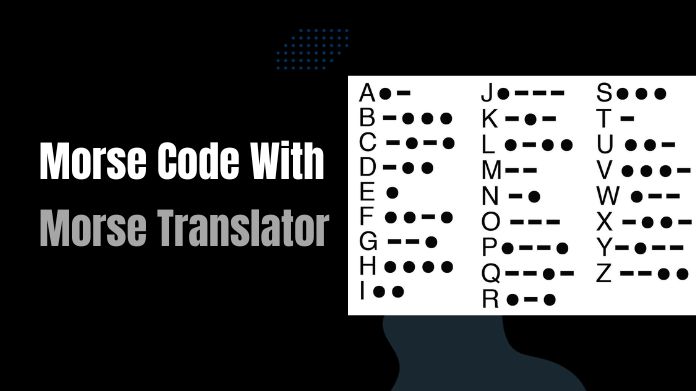In the intricate world of communication, Morse code stands as a timeless and efficient means of conveying messages through a series of dots and dashes.
Rooted in history, Morse code remains relevant in various contexts, from maritime communication to emergency signaling.
If you’re curious to unlock the secrets of Morse code or enhance your proficiency in this fascinating language, you’ve come to the right place.
This Morse Code guide is designed to introduce you to the art of Morse code, utilizing Morse translator and decoders as invaluable tools on your journey to becoming fluent in this unique method of communication.
Let’s explore Morse code, unraveling its mysteries one dot and dash at a time.
What is Morse Code?
Morse Code is a form of communication that utilizes a series of dots and dashes to represent letters and numbers. Samuel Morse and Alfred Vail developed it in the early 1830s for use with the newly invented telegraph.
Each letter and number is represented by a unique combination of short and long signals, with spaces between each letter and word.
Morse Code was widely used for long-distance communication until more advanced technologies such as the telephone and Internet were developed. However, it is still used by amateur radio operators, particularly in military and aviation applications.
How Can I Learn Morse Code?

There are several ways you can learn Morse Code. Here are a few suggestions:
1. Study resources: Start by finding books, websites, or online courses that provide detailed explanations of Morse Code. These resources often include charts with the corresponding letters and symbols. They can help you understand the basic principles of Morse Code and learn how to interpret and send messages.
2. Flashcards: Create flashcards with the letters and symbols of Morse Code on one side and the corresponding letters on the other side—practice by looking at the Morse Code side and trying to identify the corresponding letter. Then, flip the card to check if you were correct. This method can help you memorize the different codes more effectively.
3. Practice with an app or software: Various apps and software programs are available to help you practice Morse Code. These programs usually provide exercises and quizzes to test your understanding and enhance speed and accuracy.
4. Join a Morse Code community: Look for groups or communities of Morse Code enthusiasts who regularly communicate using Morse Code. Participating in these communities can allow you to practice and interact with other learners and experienced Morse Code users.
5. Use a Morse Code chart: Keep a Morse Code chart or reference guide handy while you practice. This will help you quickly look up any codes you need clarification on and reinforce your learning.
Remember, learning Morse Code requires practice and patience. Start with simple words and gradually increase the complexity as you become more comfortable with the codes.
Helpful Tips for Using the Morse Translator
1. Familiarize yourself with the Morse code alphabet: Before using the Morse translator, it’s essential to understand the Morse code alphabet. Learn the corresponding dots and dashes for each letter, number, and symbol.
2. Start with simple words and sentences: If you’re new to Morse code, it’s best to start with simple words and sentences. This will help you practice and enhance your skills gradually.
3. Use reliable Morse code resources: There are numerous Morse code resources available online, such as charts, videos, and websites. Make sure to use reliable sources to ensure accurate translations.
4. Practice listening to Morse code: Morse code is about translating, listening, and recognizing patterns. Practice listening to Morse code messages to improve your understanding and speed.
5. Take breaks: Learning Morse code can be mentally challenging, so it’s essential to take breaks when needed. Give yourself time to rest and process the information you’ve learned.
6. Keep a cheat sheet: While you’re still learning, keeping a Morse code cheat sheet handy can be helpful. This way, you can quickly reference the dots and dashes when needed.
7. Test yourself: Regularly test your Morse code skills by translating messages and checking them against reliable sources. This will help you identify areas that need improvement.
8. Use the translator as a tool, not a crutch: The Morse translator is helpful, but it’s important not to rely too heavily on it. Aim to develop your own understanding and translation skills.
9. Join a community or club: Consider joining a Morse code community or club to connect with others who are learning or experienced in Morse code. This can provide valuable support and resources.
10. Have fun and be patient: Learning Morse code takes time and practice. Remember to have fun with it and be patient as you progress.
Wrapped Up!!
Learning Morse translator may seem outdated, but it can be a fun and rewarding hobby. It can also be helpful in emergencies when other forms of communication are unavailable.
With practice and dedication, anyone can become skilled in Morse code and enjoy the thrill of sending and receiving messages in this classic code.
Happy Learning!
